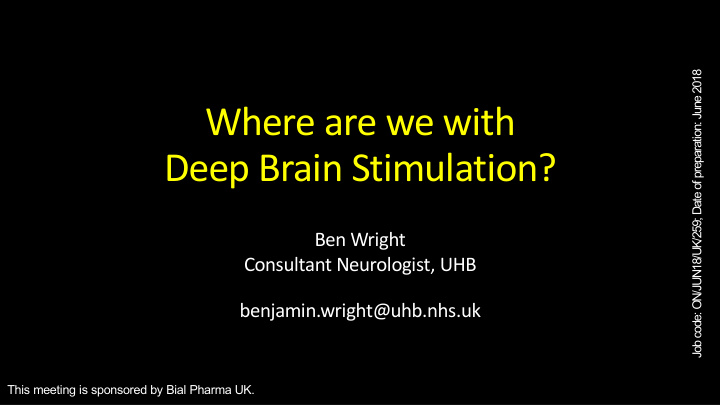



Job code: ON/JUN18/UK/259; Date of preparation: June 2018 Where are we with Deep Brain Stimulation? Ben Wright Consultant Neurologist, UHB benjamin.wright@uhb.nhs.uk This meeting is sponsored by Bial Pharma UK.
The views expressed in this presentation are those of the speaker and not necessarily those of the meeting sponsor
Declaration of Interests Abbvie Contribution to cost of event • Consultancy fee Bial Consultancy fee • Britannia Contribution to cost of event • Consultancy fee Ipsen Contribution to cost of event • Medtronic Contribution to cost of event • Profile Pharma Fee for service • UCB Fee for service •
Content • How did it develop? • How does it work? • Whom does it work for? • What’s next?
How did DBS develop? Electrical Stimulation Location targeting 1909 Horsley 2500 BC Ancient Egypt • • 1-50 AD Scribonius Largus 1937 Bucy & Case • • 1874 Roberts Bartholow 1939 Meyers • • 1947 Spiegel & Wycis • 1949 Leskell • 1952 Cooper • 1954 Hassler & Riechert 1960 Hassler • • 1961 Albe-Fessard 1963 Bekthereva • • 1965 Sem-Jacobsen •
How did DBS develop? Levodopa Technology improvements • 1957 Carlsson • CT • 1961 Hornykiewicz & • MRI Birkmayer • Battery • 1967 Cotzias • 1969 Yahr
How did DBS develop? • 1987 Benabid – Thalamic DBS • 1995 Limousin – STN DBS Okun NEJM 2012
How does it work? • Neuroprotection ? • Rate model • Modulation model • Cellular perspective
Whom to treat? Consider deep brain stimulation for people with advanced Parkinson's disease whose symptoms are not adequately controlled by best medical therapy NICE guideline (NG71) 2017
Who? Who not? • Levodopa unresponsive • Levodopa responsive symptoms symptoms • Dementia • Dyskinesia • Uncontrolled psychiatric • On-Off fluctuations disease • Tremor • No caregiver • Operative risk
Patient video
Author DBS Trial N Study Age Disease Target Duration Duration When? Deuschl 2006 STN Randomised control 78 6 months 60.5 +/- 7.4 13.0 Okun 2012 STN Open label 136 3 months 60.6 +/- 8.3 12.1 +/- 4.9 Randomised control Schüpbach 2007 STN Randomised 10 18 months 48.4 +/- 3.3 7.2 +/- 1.2 control Schüpbach 2013 STN Randomised 124 2 years 52.0 +/- 6.3 7.5 +/- 3.0 control Weaver 2009 STN Randomised 121 6 months 62.4 +/- 8.8 10.8 +/- 5.4 Follett 2010 GPi control 24 months Okun 2009 STN Randomised 45 7 months 60.0 +/- 8.2 12.9 +/- 3.8 GPi control Esselink 2004 STN Randomised control 34 6 months 61 (55-66) 12 (9-17) Pallidotomy 62 (57-68) 11 (9-16) Williams 2010 STN Open label 183 12 months 59 (37-79) 11.5 (1-30) GPi Randomised control Fraix 2006 STN Prospective cohort 95 12 months 57 +/- 8 14 +/- 5 Perriol 2006 STN Prospective cohort 58 12 months 59 (45 – 73) 14 (4 – 25) Tir 2007 STN Prospective cohort 103 12 months 58.7 +/- 8.2 13.6 +/- 4.4 Derost 2007 STN Prospective cohort 87 2 years 57.4 +/- 4.9 11.5 +/- 0.6 68.8 +/- 2.8 12.4 +/- 0.7 Ory-Magne 2007 STN Prospective cohort 45 2 years 60 +/- 9 13.5 +/- 3.6 Average 59.1 11.8
Where next?
Where next? Location targeting • Improved imaging Adapted from Coenen et al Acta Neurochirurgica 2017
Where next? Location targeting • Improved imaging • Local field recording Adapted from Accola et al Brain 2016
Where next? Location targeting • Improved imaging • Local field recording • Current steering Adapted from Martens Clinical Neurophys 2011
Where next? Refine control • Irregular stimulation • Adaptive stimulation • External feedback Adapted from Tinkhauser et al. Brain 2017
Where next?
Where next? Connectivity Disease state Target area Ideal state
Thank you benjamin.wright@uhb.nhs.uk
Recommend
More recommend